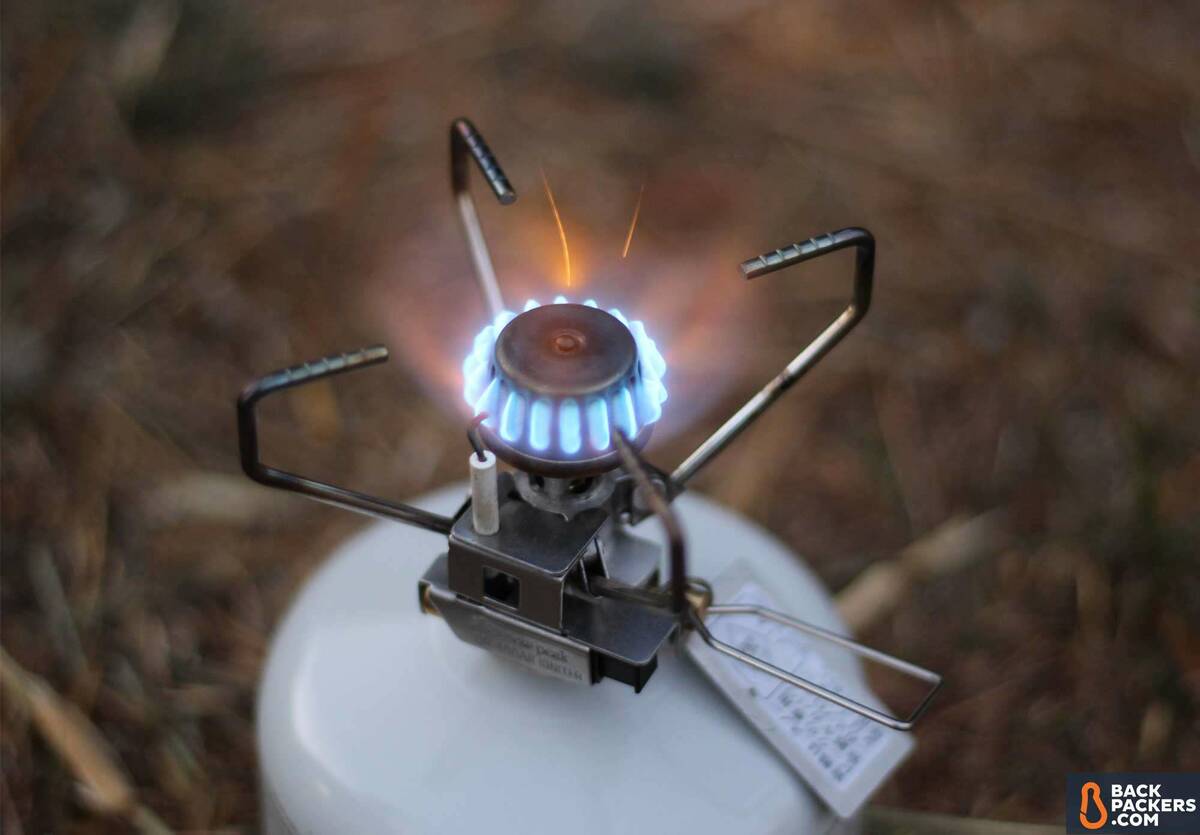Snow Peak GigaPower 2 Overview
The Snow Peak GigaPower 2 stove is a classic, heavyweight contender among remote canister backpacking stoves. You’ve probably seen that the backpacking stove market is crowded these days. There are solid, recognizable models from high-end companies, countless models you’ve probably never heard of, and a slew sold only on Amazon for next to nothing prices. How does a stove stand out?
For us, there are a few key elements: design, durability, and ease of use. A backpacking stove should be flexible enough to boil water, cook a meal, fit seamlessly in your pack, and work for years.
If there’s a stove that hits each of these marks, it’s the Snow Peak GigaPower. The original version has been the stove for lightweight backcountry chefs over the years, and Snow Peak released an update to the classic in 2017. It’s called the GigaPower 2.0, and comes in an “Auto” and “Manual” variation. This stove is light, packable, durable, and cooks like a beast.
For these reasons we have awarded the Snow Peak GigaPower 2.0 our Classic Pick for the Wilderness Backpacker.
Snow Peak GigaPower 2 Star Rating
- Stability
- Simmer
- Ease of Setup
- Boil Time
- Durability
Summary
The Snow Peak GigaPower 2 improves on the original classic, providing a tiny, capable, collapsible remote canister stove for a decent price. It can simmer, is quite stable, comes with or without piezo ignition, and has a very even distribution of flame.
While boil time isn’t the best with the GigaPower compared to some competitors, it makes up for this in simmer. If you want to cook in the country (not just boil water), consider the GigaPower 2.
As we said, it’s a crowded market. The backpacking stove that compares most closely to the GigaPower 2.0 Auto is the Jetboil MightyMo. It’s a newer stove and has the GigaPower tied or beat in nearly every category with incredible simmer control, a huge burner head, and surprising economy of fuel usage. That said, it’s lacking on durability, both from our testing and user reviews. Specifically, the Piezo ignition and the burner arms rotate slowly after use and bend quickly. Every model won’t follow suit, and you can request a replacement easily from Jetboil. But when you purchase a stove it should work for a very long time.
Learn about all the different stove types and how to make your decision in our Backpacking Stove Guide, and read the full Snow Peak GigaPower review below.
Update: Snow Peak released the 2.0 version of the GigaPower in 2017, and it has not received any updates since then. Still an excellent pick for a backpacking stove!
Snow Peak GigaPower 2 Auto Specifications
| Feature Type | Feature Specs | What This Means |
| Weight | 3.17 oz. (90 g), 3.95 oz. (112 g) with case | This is a low weight overall, but is a bit on the heavy side for canister stoves (by an half an ounce or so). The stove is easy to carry, so unless weight is your top priority, it won’t really matter. More on backpacking stove weights in our Guide. |
| Stove Type | Small Canister Stove | The GigaPower screws into a can of isobutane fuel and uses it as its base. More on backpacking stove types in our Guide. |
| Fuel Type(s) | Isobutane | Isobutane is the most common backcountry fuel, and is often found in outdoor stores. More on backpacking stove fuel types in our Guide. |
| Output | 10,000 BTU/hr | The GigaPower has an output of 10,000 BTU/hr, which is the standard for most small canister stoves. More on backpacking stove output and BTUs in our Guide. |
| Simmer Ability | Excellent | The GigaPower simmers very well due to a low flame capability and a unique burner head. You can cook real meals on this stove. More on backpacking stove simmer ability in our Guide. |
| Boil Time | 4 min. 48 sec per 1 Liter of Water (claimed) | This is the manufacturer’s claimed time. We achieved this time at sea level with a very light wind and Snow Peak branded fuel. However, at elevation in 25-40 degrees with MSR fuel, the GigaPower took over 10 minutes to boil a liter of water. More on backpacking stove boil time in our Guide. |
| Piezo Ignition? | Yes | This version comes with a Piezo ignition, which means automatic fire. This works reliably well and is handy. Always bring backup fire though. More on how Piezo ignition works (and what it is) in our Guide. |
| Included Items | Stove, White Plastic Case | The GigaPower is very simple. The stove is in one piece, and the case is two pieces, a lid and the case. You don’t have to take the case, but it’s light and handy. |
| Dimensions | Opened Size: 4.17 x 3 in. (10.6 x 7.6 cm) Packed Size: 1.5 x 3 in. (3.81 x 7.6 cm) | The GigaPower is relatively small when compacted. There are smaller stoves, especially the ones that fold into themselves more, but overall the GigaPower does just fine. It was a wide diameter when open and supports many sized pots. |
| Manufacturer Warranty | Lifetime Warranty | Snow Peak offers a lifetime warranty for all of its products. If you have an issue, get in touch. |
| Retail Price | $49.95 | A solid price for a small, durable, lightweight stove with Piezo ignition. |
Gear Review of the Snow Peak GigaPower 2
Revelation: The Moment I Knew
The Snow Peak GigaPower accompanied a group of nine on a backpacking trip into the Ansel Adams Wilderness, just outside June Lake, California. The weather in early October was surprisingly ideal — highs of 70 and lows in the mid-20s. Alpine lakes dotted the trail and while no big animals were sighted, a bald eagle soared overhead during a long day hike.

Days are made for hiking. Rush Creek in the Ansel Adams Wilderness.
Peace in the mountains, essentially.
While our group had a night of Mountain House meals, which require boiled water and nothing else, our first dinner was backcountry curry. It was delicious. And in order to cook said curry we needed three stoves and three pots. Two were used for boiling water and simmering down quinoa, while the main one was used to cook the curry mix — onions, bell peppers, coconut milk, and a handful of other ingredients, all prepared beforehand.

The Snow Peak GigaPower 2.0 Auto.
I made sure the GigaPower was the curry stove — is there a better way to test a stove’s ability to cook than give it the responsibility of a nine-person dinner? The pot was a massive, wide, three-liter behemoth that’s meant for exactly this kind of meal. The GigaPower by comparison is a tiny backpacking stove. It had no problem.
We started the meal at a low simmer, which the GigaPower does well. You do have to be gentle with the valve, turning it very slowly, or it will shut off. But getting it down to a minimum flame is easy once you know that.

From simmer to full flame.
After a few minutes of simmer we decided to crank it up, as the water was boiling and the curry ingredients weren’t properly sauteed yet. The GigaPower kept an even, wide flame and roasted the veggies into tender heaven.
Once boiled down, I added quinoa to the ginormous pot, increasing the overall load on the GigaPower, and in under 30 minutes dinner was served. Did I mention it was delicious?
Digging Deeper
There are a handful of features with the GigaPower, but there’s one main one I want to touch on: the burner head.
The GigaPower burner is not a wide, flat head that shoots its flame upwards like most other canister stoves. Instead, the flames come out of the sides of the stove in small, isolated chambers. This difference in design makes it so the GigaPower rarely gets blown out by wind. It also means the flame is much wider than other stoves, especially when a pot is placed on it.

The burner head on the GigaPower is unique. Flames come out of the small chambers, rather than the top, which creates a much wider heat distribution.
Stability 5 Stars
The GigaPower is as stable as a backpacking canister stove can get. You still have to screw the stove into a canister, so part of its stability is dependent on the size of the canister and how level your ground is, but it’s essentially a rockstar.
Why? The four pot supports. Most backpacking stoves have three pot supports, which work, but the extra one allows for better stability over a wider range of pot sizes.
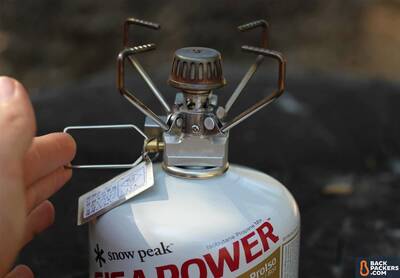
Four pot supports helps with stability.
The pot supports also extend a decent amount outward and to the center of the stove, allowing small pots, medium pots, and extra large pots to sit with ease.
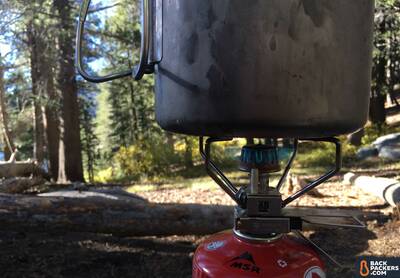
The pot supports nearly touched the edges of the Snow Peak Trek 1400 pot, which has a five inch diameter. You could go nearly double that and still be fine.
Simmer 4 Stars
The GigaPower shouts “simmer down now!” the second you light it up. You can get this flame very low, but you do have to be sensitive when turning the valve. One of the people in our group tried to get it to simmer quickly and promptly turned it off. I re-lit it in a moment with the Piezo ignition and showed him how — simmer on, Garth.
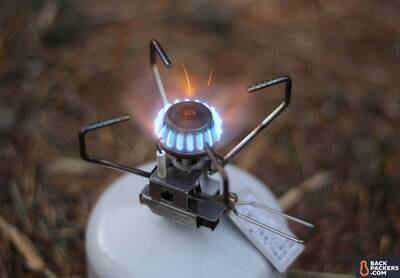
Simmering.
As I said, we cooked a big meal on a low-to-medium simmer and all our veggies came out perfect.
Ease of Setup 5 Stars
The GigaPower also excels during setup, but so do most small canister stoves. All you need for the GigaPower 2.0 Auto is a propane stove — screw it in, find a flat place, turn on the valve, and hit the Piezo ignition. Flame on!
The pot supports fold in with a simple press — fold two opposing ones first, then fold in the other two. This will let you store it in the included white box.

The folding out (or in) of the GigaPower is extremely easy.
At first it seemed really hard to get it to fit back into this box, especially with the metal tag that you’re supposed to keep on canister stoves. But after a few uses I got it down. If you ditch the box then the GigaPower is extremely easy to fold up, and gets fairly tiny.

It fits right in there. Once you get it down, it takes under five seconds to fold and store!
Boil Time 2 Stars
We camped just below the tree line in order to have a campfire at night. This meant an elevation of 9,500 feet, which put us, as they say, at “elevation.” This matters a lot for backpacking stoves, especially canister stoves. The isobutane fuel used by the GigaPower (and all canister stoves) suffers at elevation and with temperatures under 32 degrees. We cooked in both conditions, but primarily above 32 degrees.
All things considered, the boil time of the Snow Peak was sub-par, especially in the mountains. The old version was never the fastest boiler, that’s still true for the new one. In some circles that’s preferred so you can cook meals while multi-tasking, but this was a bit of a disappointment for me.
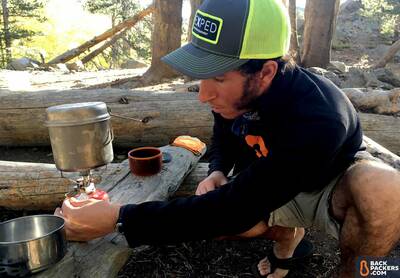
Trying to boil a liter of water at elevation with the GigaPower and an MSR fuel can. It took too long!
It took roughly 10 minutes to boil a liter of water at our campsite using an MSR fuel can with a very light wind. That’s more than double the claimed time.
Back at home, I tested the GigaPower with a Snow Peak fuel can at sea level with a very light wind. It boiled water in four minutes 14 seconds, and came to a roil at the five-minute mark. This is on par with claimed times, but I could only achieve this time with Snow Peak branded fuel at sea level.

A Snow Peak lineup. When using the GigaPower 2.0 with Snow Peak fuel it boiled water much faster.
Durability 5 Stars
As mentioned, the durability of the GigaPower is legendary. While I haven’t used this one for years, there are no issues with it after a full weekend. The level, non-rotating pot supports make for a very sturdy base and I don’t see them bending any time soon. One of the people in our group has the old version of the GigaPower, and has used it reliably for years. The Piezo still works, too.
Durability is a stand out feature, which is true for most Snow Peak products.

While this has nothing to do with durability, it’s good to know you can fit the Snow Peak GigaPower easily. It’s the white box on the top left.
Grievances
Stoves are tricky in that their environment has a lot to do with how they perform. I was disappointed with the boil times of the GigaPower at elevation. While the stove cooks and simmers extremely well, it could barely boil a liter of water, which you will be doing in the backcountry, whether it’s for meals or hot water.
On this trip there was a Jetboil MightyMo and a MSR Pocket Rocket 2 — both boiled water around the four-minute mark, as they claim, at the same elevation in the same wind conditions with the same pot.
The GigaPower did not, and I ended up using the other stoves when I wanted to boil water.
I can’t discern whether or not the fuel type was a major factor — everyone had MSR cans of fuel. I believe a stove should run equally well off any brand of fuel as long as the valves are the same, but the GigaPower performed significantly better with Snow Peak fuel back at home. If I bought this stove I would make sure to always bring Snow Peak fuel on my trips.
This water boiling issue may be a dealbreaker for some — and almost was for me. The positive factors outweigh this issue, especially if you want to do a lot of real cooking in the backcountry, but don’t expect this stove to boil water with lightning speeds.
My second grievance is more of a nitpick, but a significant one. When turned all the way off, the GigaPower’s valve handle doesn’t line up with the bottom of the stove. This makes it so you can’t flip the valve up under the stove for easy storing. Instead, you have to twist the valve into the “on” position, then flip it under.
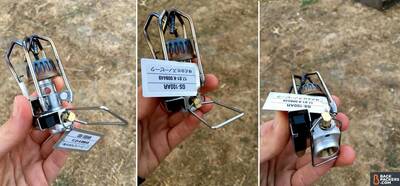
Left to right: Position of valve in full off mode, position of valve needed to fold under, valve folded under. The valve is technically on in this position.
Because of this, one person in our group twisted the GigaPower onto a fuel can and heard the gas running immediately, which is a waste of fuel and a hazard. I know better, and always turn the valve off again before screwing it onto a canister, but Snow Peak should really manufacturer the valve to line up perfectly in the off position.
Final Word
The Snow Peak GigaPower stove allows you to make delicious backcountry curry, or pretty much any meal of your choosing. It’s stable, powerful, and will last a lifetime.
Where to Buy Snow Peak GigaPower
We tested the Snow Peak GigaPower 2.0 Auto, which was released in 2017. It is a small update to the original GigaPower, better known as the Snow Peak GigaPower Auto. (No “2.0”). The main differences between the old and new version are a slight reduction in weight — about .5 ounces — and, according to Snow Peak, a more durable design. The original was very durable as well.
The main way to tell these two apart, besides their unique product IDs, is the size and shape of the valve. The new GigaPower stoves have a rectangular valve that is short. The old GigaPower has a triangular shaped valve that is much longer. We actually prefer the longer valve for easy turning, but the new one has slightly finer control for simmering.
This difference is true on the Auto and Manual versions of the GigaPower. The Auto, which we tested, has a Piezo ignition for matchless lighting. The Manual does not have a Piezo. We think the convenience is worth the extra $10, especially because the Snow Peak Piezo design is known for lasting. However, if that doesn’t matter to you, grab the Manual version.
Finally, Snow Peak sells a nifty windscreen for the GigaPower stove. It fits on any GigaPower (new, old, Auto, Manual), and is designed brilliantly. It helps to cut wind and reflects heat back up to the pot, thereby cutting down boil times. We recommend it as well.
Compare Snow Peak GigaPower prices below, and look for the new version by the size and shape of the valve.
